#gsd structure
Text
ah the dichotomy of discussing a gsd/husky/malamute mix's structure and the difference in opinion on how terrible the pasterns are from a GSD person's perspective (normal!) to the husky/malamute people's perspective (absolutely horrid and non functional, do limited activity with this dog).
#dogblr#dog structure#like also:#a dog gotten for sled work with the pasterns of a gsd is not a mushing prospect in any regard#so why they gsd folks are arguing it's perfectly okay when it's not even a good pastern for a gsd blows my mind#like if i saw a dog like the one i just saw online in person i would be certain it was in need of serious medical help#like bad pasterns and also knuckling but you know.#just normal gsd things#(not saying gsd's dont have functional pasterns btw)#(just that a lot of gsd people are really blind to pastern extremes because of what they're used to seeing within the breed)
26 notes
·
View notes
Text


„A house is a work of art“ is one of three theses Kazuo Shinohara (1925-2006) formulated in the early 1960s which also entailed the conclusion that the expression of a modern townscape must be found in the beauty of chaos rather than harmony. Between these poles Shinohara sounded out the relationship between the house and the city, a process that resulted in truly fascinating and poetic constructions. Shinohara, who had started out studying mathematics before ultimately settling for architecture, first experimented with variations of the square as e.g. exemplified by his Umbrella House (recently reassembled on the Vitra Campus) before designing more complex structures. What connects all of Shinohara’s works is a decided lucidity that he at times even developed into a beautiful ephemerality.
In the third volume of their ongoing series of books dealing with Japanese postwar architects the Harvard GSD and Lars Müller Publishers in 2020 took to Shinohara and with „Kazuo Shinohara: Traversing the House and the City“ provide a thorough study of Shinohara’s domestic architecture.
Editor Seng Kuan identified four stylistic periods in Shinohara’s oeuvre that form the backbone of the book: each period is represented by several houses that are extensively documented in photos, drawings and plans. Around these theoretical excursions, interviews and archival material build up a second layer of insights into Shinohara’s work, most notably through photographs the architect took of buildings all around the world which demonstrate his deep interest in understanding architecture and urbanism way beyond Japan.
Shinohara’s curiosity and ingenuity actually traverses the entire book and which opens up a unique architectural cosmos. By virtue of the juxtaposition of theoretical elaborations, interviews, built and unbuilt works as well as material from Shinohara’s archive the book is an exciting read and a highly recommended deep drilling into a fascinating oeuvre!
#kazuo shinohara#japanese architecture#architecture book#architecture#japan#monograph#lars muller publishers
46 notes
·
View notes
Text
hierarchy of factors that go into deciding which dogs to assign to different characters
physical features (fur color, typical fur length/cut, fur texture, facial structure etc.) -> type of dog/role they were bred for -> personality -> global origin
big example of the typical fur length/cut being a big factor is heather being a Japanese Chin which are seen with both long and short fur. subtle nod to her hair getting cut (julia has this in common w her being a yorkie)
they do tend to bounce around in terms of importance per character so i.e. duncan is a German Shepard bc of their association with the police force since he comes from a long lineage of cops (this is from the tdi biography/interview thing). basically i thought his backstory was more relevant to his character than his looks (though i do think he looks a lot like a gsd too which is why i chose it over any other police dog breed. that and theyre the most recognizable lol)
a lot of characters go through a few beta picks before i settle on one i feel fits better for whatever reason. easiest example that comes to mind was owen originally going to be a labrador retriever before i decided pyrenees looked more like him. in a world where great pyranees dont exist though i would settle for lab for owen.
final thing, some characters i like got breeds im partial to. nepo babies, all of them🤦 courtney is a papillon bc i like papillons. sierra is a jack russell bc i love jack russells (and also they act the exact same) dakota is a cocker spaniel bc i like them. basically lol
#if anyone wonders for spesific characters their reasoning lmk bc i love yapping (dog pun)(i fucking love dogs)#as always though some are a lot deeper than others#be prepared for a “they looked kinda similar” answer lmaooo#ps talks
2 notes
·
View notes
Text

Wólfram and Tumultuous design differences; the Shapeshifters will always have a dark iridescent coat, but can have varied appearances within the same species - including different skeletal structures as noted between Wólf’s modern GSD-like conformation VS Tumult’s straight-backed one
2 notes
·
View notes
Note
Afaik we don’t have any real wolfdogs here in Australia, but a fb acquaintance has been bragging about her new Lyksos (?) puppy. Apparently it’s a brand new breed here and they’re “dogs in wolfsuits”. From what I could see on their website, the dogs are mostly malamute X German shepherd. The breeder claims the dogs are all fully health and genetic tested, but the facial structure of the dogs make me think of those white tigers with Downs Syndrome (I don’t think that’s what it is but I can’t remember properly right now). Just needed to share cos I don’t understand the obsession with wanting to own a wolf…
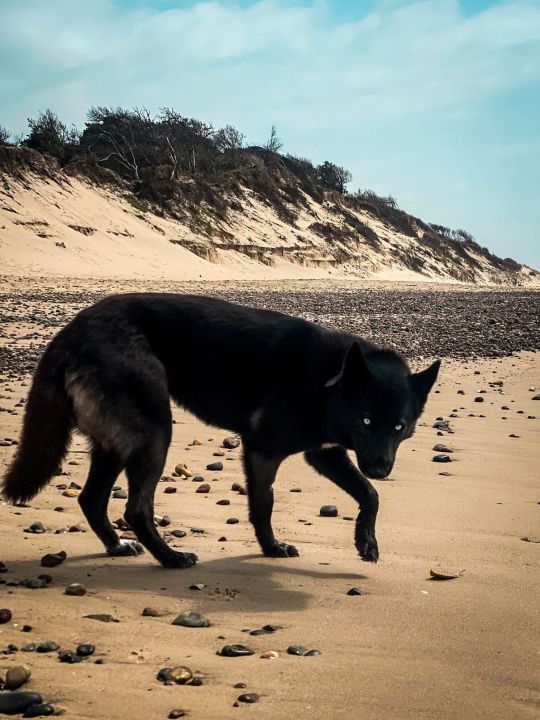

I do find it hard to believe that these two different dogs aren't [very] low contents. This is off the website of one of the Lykos breeders listed on the official Lykos website. I went looking for the exact breed mix and once again found a lot of coy "oh you know, gsd, husky, and related breeds..." wording but no actual list. I'm wondering if this is similar to the Tamaskan/Utonagan/Northern Inuit situation, where Sarloos Wolfhound or Czech Wolfdog was used and they are technically [very] low contents as a result. Or if they used those aforementioned wolfalikes, which vary by line but do have some low content wolfdog mixed in there, and again thus have created more [very] low content wolfdogs.
Does Australia allow the import of the four recognized purebred wolfdog breeds, or those wolfalikes I mentioned? If so, then I think I've figured it out.
I'm not really seeing anything that looks like the super inbred white tigers. A lot of photoshop on the eyes though.
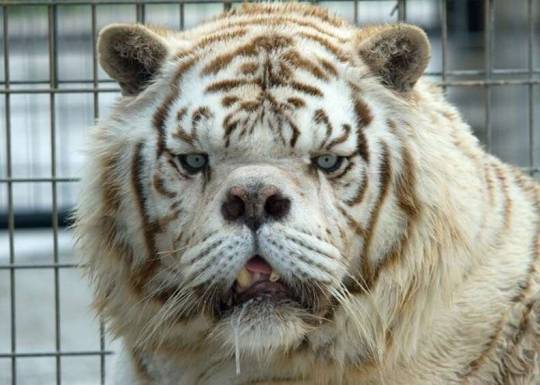
64 notes
·
View notes
Text
Creative collisions: Crossing the art-science divide
New Post has been published on https://sunalei.org/news/creative-collisions-crossing-the-art-science-divide/
Creative collisions: Crossing the art-science divide
MIT has a rich history of productive collaboration between the arts and the sciences, anchored by the conviction that these two conventionally opposed ways of thinking can form a deeply generative symbiosis that serves to advance and humanize new technologies.
This ethos was made tangible when the Bauhaus artist and educator György Kepes established the MIT Center for Advanced Visual Studies (CAVS) within the Department of Architecture in 1967. CAVS has since evolved into the Art, Culture, and Technology (ACT) program, which fosters close links to multiple other programs, centers, and labs at MIT. Class 4.373/4.374 (Creating Art, Thinking Science), open to undergraduates and master’s students of all disciplines as well as certain students from the Harvard Graduate School of Design (GSD), is one of the program’s most innovative offerings, proposing a model for how the relationship between art and science might play out at a time of exponential technological growth.
Now in its third year, the class is supported by an Interdisciplinary Class Development Grant from the MIT Center for Art, Science and Technology (CAST) and draws upon the unparalleled resources of MIT.nano; an artist’s high-tech toolbox for investigating the hidden structures and beauty of our material universe.
Play video
Creating Art, Thinking Science Class at MIT
Video: Arts at MIT
High ambitions and critical thinking
The class was initiated by Tobias Putrih, lecturer in ACT, and is taught with the assistance of Ardalan SadeghiKivi MArch ’23, and Aubrie James SM ’24. Central to the success of the class has been the collaboration with co-instructor Vladimir Bulović, the founding director of MIT.nano and Fariborz Maseeh Chair in Emerging Technology, who has positioned the facility as an open-access resource for the campus at large — including MIT’s community of artists. “Creating Art, Thinking Science” unfolds the 100,000 square feet of cleanroom and lab space within the Lisa T. Su Building, inviting participating students to take advantage of cutting-edge equipment for nanoscale visualization and fabrication; in the hands of artists, devices for discovering nanostructures and manipulating atoms become tools for rendering the invisible visible and deconstructing the dynamics of perception itself.
The expansive goals of the class are tempered by an in-built criticality. “ACT has a unique position as an art program nested within a huge scientific institute — and the challenges of that partnership should not be underestimated,” reflects Putrih. “Science and art are wholly different knowledge systems with distinct historical perspectives. So, how do we communicate? How do we locate that middle ground, that third space?”
An evolving answer, tested and developed throughout the partnership between ACT and MIT.nano, involves a combination of attentive mentorship and sharing of artistic ideas, combined with access to advanced technological resources and hands-on practical training.
“MIT.nano currently accommodates more than 1,200 individuals to do their work, across 250 different research groups,” says Bulović. “The fact that we count artists among those is a matter of pride for us. We’ve found that the work of our scientists and technologists is enhanced by having access to the language of art as a form of expression — equally, the way that artists express themselves can be stretched beyond what could previously be imagined, simply by having access to the tools and instruments at MIT.nano.”
A playground for experimentation
True to the spirit of the scientific method and artistic iteration, the class is envisioned as a work in progress — a series of propositions and prototypes for how dialogue between scientists and artists might work in practice. The outcomes of those experiments can now be seen installed in the first and second floor galleries at MIT.nano. As part of the facility’s five-year anniversary celebration, the class premiered an exhibition showcasing works created during previous years of “Creating Art, Thinking Science.”
Visitors to the exhibition, “zero.zerozerozerozerozerozerozerozeroone” (named for the numerical notation for one nanometer), will encounter artworks ranging from a minimalist silicon wafer produced with two-photon polymerization (2PP) technology (“Obscured Invisibility,” 2021, Hyun Woo Park), to traces of an attempt to make vegetable soup in the cleanroom using equipment such as a cryostat, a fluorescing microscope, and a Micro-CT scanner (“May I Please Make You Some Soup?,” 2022, Simone Lasser).
These works set a precedent for the artworks produced during the fall 2023 iteration of the class. For Ryan Yang, in his senior year studying electrical engineering and computer science at MIT, the chance to engage in open discussion and experimental making has been a rare opportunity to “try something that might not work.” His project explores the possibilities of translating traditional block printing techniques to micron-scale 3D-printing in the MIT.nano labs.
Yang has taken advantage of the arts curriculum at MIT at an early stage in his academic career as an engineer; meanwhile, Ameen Kaleem started out as a filmmaker in New Delhi and is now pursuing a master’s degree in design engineering at Harvard GSD, cross-registered at MIT.
Kaleem’s project models the process of abiogenesis (the evolution of living organisms from inorganic or inanimate substances) by bringing living moss into the MIT.nano cleanroom facilities to be examined at an atomic scale. “I was interested in the idea that, as a human being in the cleanroom, you are both the most sanitized version of yourself and the dirtiest thing in that space,” she reflects. “Drawing attention to the presence of organic life in the cleanroom is comparable to bringing art into spaces where it might not otherwise exist — a way of humanizing scientific and technological endeavors.”
Consciousness, immersion, and innovation
The students draw upon the legacies of landmark art-science initiatives — including international exhibitions such as “Cybernetic Serendipity” (London ICA, 1968), the “New Tendencies” series (Zagreb, 1961-73), and “Laboratorium” (Antwerp, 1999) — and take inspiration from the instructors’ own creative investigations of the inner workings of different knowledge systems. “In contemporary life, and at MIT in particular, we’re immersed in technology,” says Putrih. “It’s the nature of art to reveal that to us, so that we might see the implications of what we are producing and its potential impact.”
By fostering a mindset of imagination and criticality, combined with building the technical skills to address practical problems, “Creating Art, Thinking Science” seeks to create the conditions for a more expansive version of technological optimism; a culture of innovation in which social and environmental responsibility are seen as productive parameters for enriched creativity. The ripple effects of the class might be years in the making, but as Bulović observes while navigating the exhibition at MIT.nano, “The joy of the collaboration can be felt in the artworks.”
0 notes
Text
Creative collisions: Crossing the art-science divide
New Post has been published on https://thedigitalinsider.com/creative-collisions-crossing-the-art-science-divide/
Creative collisions: Crossing the art-science divide
MIT has a rich history of productive collaboration between the arts and the sciences, anchored by the conviction that these two conventionally opposed ways of thinking can form a deeply generative symbiosis that serves to advance and humanize new technologies.
This ethos was made tangible when the Bauhaus artist and educator György Kepes established the MIT Center for Advanced Visual Studies (CAVS) within the Department of Architecture in 1967. CAVS has since evolved into the Art, Culture, and Technology (ACT) program, which fosters close links to multiple other programs, centers, and labs at MIT. Class 4.373/4.374 (Creating Art, Thinking Science), open to undergraduates and master’s students of all disciplines as well as certain students from the Harvard Graduate School of Design (GSD), is one of the program’s most innovative offerings, proposing a model for how the relationship between art and science might play out at a time of exponential technological growth.
Now in its third year, the class is supported by an Interdisciplinary Class Development Grant from the MIT Center for Art, Science and Technology (CAST) and draws upon the unparalleled resources of MIT.nano; an artist’s high-tech toolbox for investigating the hidden structures and beauty of our material universe.
Play video
Creating Art, Thinking Science Class at MIT
Video: Arts at MIT
High ambitions and critical thinking
The class was initiated by Tobias Putrih, lecturer in ACT, and is taught with the assistance of Ardalan SadeghiKivi MArch ’23, and Aubrie James SM ’24. Central to the success of the class has been the collaboration with co-instructor Vladimir Bulović, the founding director of MIT.nano and Fariborz Maseeh Chair in Emerging Technology, who has positioned the facility as an open-access resource for the campus at large — including MIT’s community of artists. “Creating Art, Thinking Science” unfolds the 100,000 square feet of cleanroom and lab space within the Lisa T. Su Building, inviting participating students to take advantage of cutting-edge equipment for nanoscale visualization and fabrication; in the hands of artists, devices for discovering nanostructures and manipulating atoms become tools for rendering the invisible visible and deconstructing the dynamics of perception itself.
The expansive goals of the class are tempered by an in-built criticality. “ACT has a unique position as an art program nested within a huge scientific institute — and the challenges of that partnership should not be underestimated,” reflects Putrih. “Science and art are wholly different knowledge systems with distinct historical perspectives. So, how do we communicate? How do we locate that middle ground, that third space?”
An evolving answer, tested and developed throughout the partnership between ACT and MIT.nano, involves a combination of attentive mentorship and sharing of artistic ideas, combined with access to advanced technological resources and hands-on practical training.
“MIT.nano currently accommodates more than 1,200 individuals to do their work, across 250 different research groups,” says Bulović. “The fact that we count artists among those is a matter of pride for us. We’ve found that the work of our scientists and technologists is enhanced by having access to the language of art as a form of expression — equally, the way that artists express themselves can be stretched beyond what could previously be imagined, simply by having access to the tools and instruments at MIT.nano.”
A playground for experimentation
True to the spirit of the scientific method and artistic iteration, the class is envisioned as a work in progress — a series of propositions and prototypes for how dialogue between scientists and artists might work in practice. The outcomes of those experiments can now be seen installed in the first and second floor galleries at MIT.nano. As part of the facility’s five-year anniversary celebration, the class premiered an exhibition showcasing works created during previous years of “Creating Art, Thinking Science.”
Visitors to the exhibition, “zero.zerozerozerozerozerozerozerozeroone” (named for the numerical notation for one nanometer), will encounter artworks ranging from a minimalist silicon wafer produced with two-photon polymerization (2PP) technology (“Obscured Invisibility,” 2021, Hyun Woo Park), to traces of an attempt to make vegetable soup in the cleanroom using equipment such as a cryostat, a fluorescing microscope, and a Micro-CT scanner (“May I Please Make You Some Soup?,” 2022, Simone Lasser).
These works set a precedent for the artworks produced during the fall 2023 iteration of the class. For Ryan Yang, in his senior year studying electrical engineering and computer science at MIT, the chance to engage in open discussion and experimental making has been a rare opportunity to “try something that might not work.” His project explores the possibilities of translating traditional block printing techniques to micron-scale 3D-printing in the MIT.nano labs.
Yang has taken advantage of the arts curriculum at MIT at an early stage in his academic career as an engineer; meanwhile, Ameen Kaleem started out as a filmmaker in New Delhi and is now pursuing a master’s degree in design engineering at Harvard GSD, cross-registered at MIT.
Kaleem’s project models the process of abiogenesis (the evolution of living organisms from inorganic or inanimate substances) by bringing living moss into the MIT.nano cleanroom facilities to be examined at an atomic scale. “I was interested in the idea that, as a human being in the cleanroom, you are both the most sanitized version of yourself and the dirtiest thing in that space,” she reflects. “Drawing attention to the presence of organic life in the cleanroom is comparable to bringing art into spaces where it might not otherwise exist — a way of humanizing scientific and technological endeavors.”
Consciousness, immersion, and innovation
The students draw upon the legacies of landmark art-science initiatives — including international exhibitions such as “Cybernetic Serendipity” (London ICA, 1968), the “New Tendencies” series (Zagreb, 1961-73), and “Laboratorium” (Antwerp, 1999) — and take inspiration from the instructors’ own creative investigations of the inner workings of different knowledge systems. “In contemporary life, and at MIT in particular, we’re immersed in technology,” says Putrih. “It’s the nature of art to reveal that to us, so that we might see the implications of what we are producing and its potential impact.”
By fostering a mindset of imagination and criticality, combined with building the technical skills to address practical problems, “Creating Art, Thinking Science” seeks to create the conditions for a more expansive version of technological optimism; a culture of innovation in which social and environmental responsibility are seen as productive parameters for enriched creativity. The ripple effects of the class might be years in the making, but as Bulović observes while navigating the exhibition at MIT.nano, “The joy of the collaboration can be felt in the artworks.”
#000#2022#2023#250#3d#anniversary#architecture#Art#artists#Arts#atomic#atomic scale#atoms#attention#Building#career#Center for Art#Science and Technology#Classes and programs#Collaboration#collisions#Community#computer#Computer Science#consciousness#creativity#cutting#Design#development#devices
0 notes
Text
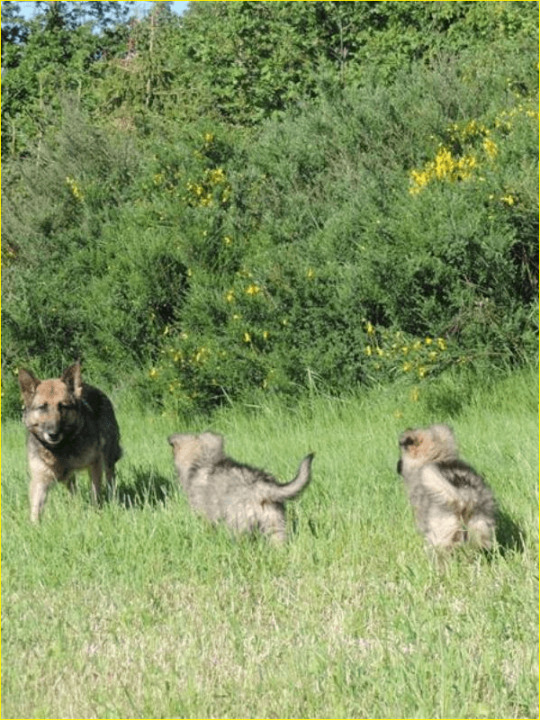
Breed-related diseases of your German Shepherd Dog
This holds true for both humans and animals. The best treatment is to diagnose an illness early and prevent it from spreading. You must be aware of the symptoms. Here are some recognized diseases and health difficulties in German shepherds:
Pituitary short stature- Dwarfism, or short stature, is a sickness caused by a genetic abnormality that most commonly affects the German shepherd and other dog breeds when bred with the German shepherd. As a result, the origin is established. Growth halts due to low levels of growth hormones and thyroxine in the blood. It is already apparent in the first few weeks of the puppies' lives. We're dealing with hypothyroidism here, which is easily treated if caught early. A DNA test can provide the breeder with timely knowledge, preventing the disease. This hormonal imbalance produces further health issues for the dog. Skin deformities can occur, but internal organ issues can also occur. Because the vertebrae are all too short, the German shepherd can be susceptible to pain. However, the dog's proportionate appearance is unaffected by his tiny stature.
Eye diseases- Color blindness is considered a hereditary eye disease. This condition is also referred to as day blindness. The dog's vision is affected by bright sunshine, with the disturbance decreasing as the light level falls. Day blindness is caused by defects in the photoreceptors of the retina, which are responsible for seeing bright lights.
Color blindness in dogs is caused mostly by eye dysfunctions such as cone photoreceptor dysfunction, severely diminished vision, photophobia, and reduced or whole-color vision loss, all of which contribute to color blindness. Hereditary cataracts are similar to human cataracts, a clouding of the lens, which leads to impaired vision. Unfortunately, many difficulties in the dog's eye are not detectable in time. They are frequently only noticed when they have reached the last stage. A tonometer can be used to assess the internal pressure of the eye and thereby identify and treat existing glaucoma (which the German shepherd rarely has). Ultrasound is important, as is an ophthalmoscope, which can reveal abnormalities in the eye's structures. Another prevalent condition is chronic superficial keratitis, which is both persistent and incurable.
However, if the GSD's vision is to be saved, it must be regulated. Failure to do so may result in the dog being completely blind. If you catch the signs early enough, you can save your sight for life. Because the dog's condition develops at a young age, the possibilities of this happening are fairly significant. First, there is eye redness. The cornea becomes gray-blue and stores black pigments as a result of this inflammation. This is rather obvious since the dog will squint and frequently drink. These symptoms are easily and efficiently addressed with medication; only the color deposits (pigments) are permanent. Although the precise etiology of this disease is unknown, we do know that the eye's immune system abruptly turns against itself and targets the conjunctiva and cornea of the eye. High solar radiation is thought to be one of the primary culprits. Because it's difficult to put sunglasses on your dog for safety (you're allowed to try, but it looks goofy and he'll attempt to pull them off), avoid going to the ocean, beaches, high mountains, and lakes.
So make sure to organize your holiday plans with your four-legged companion. Previously, eye infections were treated with cortisone-containing drops and ointments, but these had severe adverse effects. Fortunately, research is continually progressing, and there are now medications containing "ciclosporins" that have no severe negative effects. They have an effect on the faulty immune system, causing the inflammation to diminish. It can eliminate vast amounts of growing tissue across the cornea. It must be understood that suitable therapy must be monitored and delivered throughout a person's life. An operation is not required; it is even discouraged!
Caution: There are phases that make it appear as if the sickness has vanished. Unfortunately, this is not the case. It's simply rest periods. German shepherd keratitis, like all diseases, must be identified and treated as soon as possible. So it is preferable to visit the ophthalmologist more than once.
Pyoderma- This could be a metabolic disorder (an underlying problem that needs to be addressed) or a non-healing wound deeper beneath the skin and fur. If these cures slowly or not at all, please see your veterinarian, who will evaluate what the problem is. Mites and/or fleas should also be considered. If the dog owner notices their dog licking or scratching at the spots, they should put a neck brace on them (the dogs despise this and never get tired of removing it). Simply place a sock over the dog's paw to prevent scratching. He'll also be annoyed because it hinders his sense of touch while walking and jogging. Still preferable to infecting the wound and making it worse than it already is. The most important thing is to keep licking to a minimum. Bacteria may enter the wound and cause even more severe and hazardous inflammation. To ease the dog's itching, shave the fur around the wound's edges. Licking can also be avoided by using a wound spray that the dog dislikes. Iodine compresses, which are applied to the wound for a few minutes and then changed every 2-3 hours, are also relaxing and disinfecting. Priority number one: only the veterinarian knows what is beneficial for the dog. Never do your tests without a prescription, as they may be more harmful than beneficial.
Degenerative myelopathy (also called German shepherd myelopathy) - This incurable condition only affects older dogs (typically between the ages of 8 and 10). This is a spinal-cord neurological disorder. It is easily identified if the dog, for example, stumbles or even falls over when turning, covers its paws with feces, or drags its toes or claws to aggravate the illness. In the worst-case scenario, both rear limbs are compromised, which means the dog can no longer stand on its own and cannot walk without assistance. Finally, all that remains is to redeem the dog and put it to sleep. Anyone who has had to put this into action understands how difficult, if not impossible, it is. The belief that the animal will be redeemed is the only thing that helps. There is no pain, but if you prolong and delay your death against all odds, you risk spreading the sickness to your front limbs and causing more ataxia (poor movement coordination). You should avoid adding to your dog's failures.
Von Willebrand's disease (vWD) - Von Willebrand's disease (vWD) is also common in German Shepherds. Type 1 vWD is a recessively inherited blood condition characterized by a lack of Willebrand factor (vWD). This is a key coagulation factor, and bleeding can occur as a result of a lack of it. A DNA test for Von Willebrand's disease (vWD) can provide early detection and help identify the carrier of this dangerous blood illness. Fortunately, we can now have DNA testing performed for a variety of disorders, allowing us to discover pathogens in time to combat them.
0 notes
Note
Yknow, I think I'm starting to unlearn the whole "breed doesn't matter!! Stop pit bull hate!!!" mentality, but I'm still stuck in some kind of cognitive dissonance. Could you explain more about the situation? I guess I'm afraid to learn about the truth of the matter from non-biased sources, mostly bc of a family situation.
Anecdote time: I know my brother has his heart in the right place but he keeps adopting random strays without knowing how to manage/train them properly-- I love those 3 girls to death but two, the big pit mix (sweetheart with humans, domineering at dog parks, built like a tank) and German shep (also sweetheart, *very* energetic, not walked enough) have recently been ganging up on the newer one (husky mix, somewhat skittish and prim, a diva who loves very selectively) to the point that we volunteered to take care of the pit so the husky girl can catch a break from their pack mentality.
My bro is very torn up about this but honestly it's a long time coming, he's a workaholic who never took our advice seriously (we have trained/raised two large working breeds and have given *HIS* dogs basic training on normal family visits just bc they really needed it) and his dogs get left alone in his yard during the day-- the breaking point is when the husky girl got minor but still skin breaking injuries from one of the dogs. Pit is staying with us and our Belgian sheepdog mix who is quite good with her, they've had no issues since this started, and the other two are now getting along better. I feel for him but I'm out of pity at this point and honestly patience. His girls don't deserve this, especially not the husky :(
This is definitely a hard situation to be in, so i feel for you.
I would absolutely encourage him to rehome the husky. TBH he doesn't sound like he's providing enough enrichment or exercise to his pitty or GSD, either - two breeds that can be VERY driven and will start exhibiting "problematic" behaviors such as destructiveness when they are under exercised. So adding a third, highly energetic breed to the mix just isn't going to work for him. I think if he does not intervene the husky will just get hurt again; and the only way i can think of that would make his "pack" work would be to completely reintroduce the husky by following a highly structured routine (ie letting them walk together and meet in a neutral area outside of the home/yard, separating them in the home and feeding them nearby each other with a barrier between them, etc. before letting them loose together in the house) or to implement a strict crate and rotate schedule. I don't really see that happening with your brother being so busy with work that he can't even spend much time with his current dogs.
(FTR i am only mentioning this because it is relevant - want to stress i am not moralizing aggression at all, just want to make a point. While many pitties don't exhibit dog aggression, the fact of the matter is, not too long ago, they were used in bloodsports - namely dog fighting - and were often meant to kill other dogs in the ring. While dogfighting was banned a few decades ago, many pit bulls STILL have dog aggression, because that was so thoroughly bred into them, and newbie owners either don't *want* to recognize this or don't know the history because of pitbull PR (ie the nanny dog myth). Sooo sometimes people try to have their pitbulls interact with other dogs without knowing for sure that their dogs are dog social, which can sometimes end pretty disastrously. Not saying your brother's dog is like this at all, but it's entirely possible for a dog aggressive pit to be ok with one or two dogs and NOT be okay with other dogs)
i know sometimes with social interactions dogs do try to establish social dynamics with each other in order to reduce conflict in the long run (not like a linear hierarchy, but they do seem to have a pecking order of sorts that can be dynamic and change at any time) so it's possible the two girls are trying to put the husky in her "place", and the husky is not tolerating it. Ive seen this happen in dog play groups many times, where there are basically dogs that will bully and challenge other dogs to vie for a better "rank", which usually either ends up with one dog ""submitting"" orrrr a dog fight.
(I am trying to avoid using the word dominance but i know sometimes it is appropriate, but i am NOT by any means an animal behaviorist so i do not want to lead you astray)
BTW If anyone dogblr following me wants to correct anything ive mentioned please don't hesitate to do so lol im pretty new to dog behavior and willing to learn more!
as for why breed matters. that is a whole can of worms that i dont think i can answer fully, but I'll say this. Dogs, since the beginning, have been bred to do different tasks for/with humans. Every breed has been so thoroughly refined over the last 1000s of years that their literal wolf/predator instincts have morphed into tasks that are useful for humans - dogs like collies know how to herd without being taught, sight hounds want to chase, terriers instinctively bite-kill vermin/small animals, retrievers are compelled to retrieve, etc. you get the drill. wolves on the other hand are compelled to complete the prey sequence, which ends in consumption of prey. (it isnt quite this simple really, and dogs can absolutely still have the compulsion to complete the prey sequence, but i just want to try to make some sense) Wild wolves also aren't nearly as attentive to humans as dogs are; dogs have literally been bred to be attuned to our body language and our emotions, and are also way more dependent on humans than wolves are.
There's a video actually that i think beautifully demonstrates this by showing the difference between how a collie and greyhound respond to a mechanical hare, i cant find it but i will try to describe it. A mechanical hare is running. The greyhound races to catch it by chasing it around the track. The border collie does not chase, but attempts to cut off the hare at the front. Same prey drive, with different parts of the prey sequence being used (greyhound - chase; collie - eye/stalk)
Until very recently, while dogs have always been cherished companions, they have also been "tools" used for very specific functions/jobs to help humans. Nowadays the need for dogs in specific tasks has decreased dramatically, and dogs with say, high drive, are being placed in homes that do not know how to fulfill those needs. Border collies without something to do are probably the most anxious creatures you will ever meet. Terriers adopted to families with cats or small animals are sometimes in for an unfortunate accident, if they don't know better. People who own hounds sometimes don't understand at all why their dog is so loud and barks so much. It's so incredibly vital that people understand dog breeds as they are, not fault them for their literal genetics, and have realistic expectations for living with and training dogs of a certain breed.
All that is to say, yes dogs have personalities, yes dogs are individuals, and yes dog breeds are also basically GMO wolves that live inside of our homes, rent free. Knowing the breed your dog is will set you and your dog up for success in whatever it is you want to do with your dog, whether it is having a companion, doing dog sports, hunting, training in service work, etc.
1 note
·
View note
Text
Trying to actually get some structure in my blog (mostly because I forget the god damned tags I use)
If you want me to add some trigger tags, tell me! I'll tag them as "tw: ___"
#Obscure Feelings - exactly what it sounds like. I may not make many of them but I like them all.
#Tell-a-Tale - for my own stories
#GSD's YGO Story Zine - short memories I have about Yugioh, my beloved and beloathed card game.
If you just want my art, I've made a sideblog named GoldenArtyDolphin! You can also find my other zines/art on this blog with #my art!
#tale told - gonna try to remember putting this when I reblog stories from others
#art - bookmarks for other people's art. I'll try to also keep the material in it if I can (though I might be wrong!).
#.txt - Things I tag on or write. Used to be only for posts I wrote entirely myself, but that's changed. I comment through tagging so much more often than I write my own posts and I wanted to have them collated.
#ttrpg - any pathfinder or similar related stuff
#rant - did you want my unwarranted opinion on stuff? No? Well, tough (they are good rants though)
#ask/answer - asks I answered. Always happy to get attention lol
#noticed >w<7 - asks of mine that got answered. Gotta pepper a bit of fun in there until I find a better tag
#avert thine eyes Hibi - secrets from a specific mutual (hehe)
#tagsplanation - for posts like this. I like the pun
you might find tags that end in "idea" but nothing I want to put up here at the moment. My content is just idle vapors of a mind diseased anyways
Are there more? Probably! Did I remember the bloody tags I used? Nope :D
1 note
·
View note
Photo
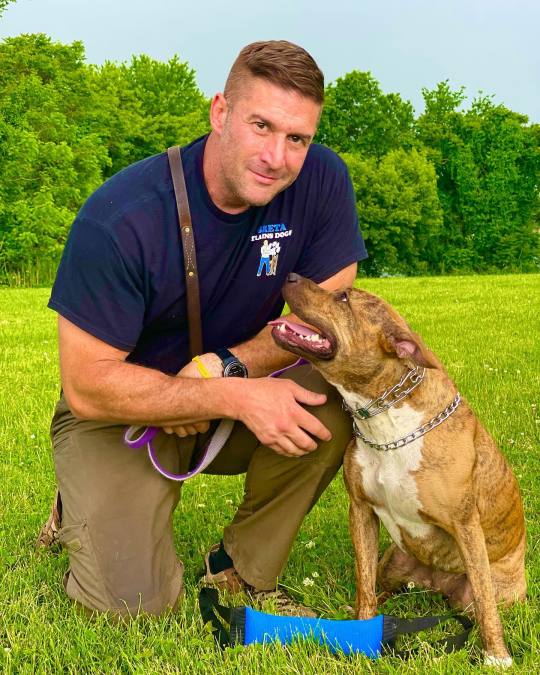
#dogtraining #anxiety Let’s examine some #mentalhealth and how it relates to #dogs. Lacy, the #pitbull had just finished a structured play session here. We bonded over the course of the experience, as her look of adoration suggests. It wore us both to the point of utter exhaustion, but it was that shared activity that helped form and strengthen our bond. Yes, she was on point that day, but remember, dogs, much like people have good and bad days. It’s important we gauge progress on a greater scale, as opposed to using a micrometer. It’s ok to stumble, as long as you stumble forward. It’s ok not to be where you want, as long as you’re not where you were. Learn a new perspective on progress. Learn a new perspective of yourself and your dog through benevolent leadership. #dogtrainer #dog #dogsofinstagram #pitbullsofinstagram #gsd #germanshepherd #frenchbulldog #pitbulls #goldenretriever #siberianhusky #husky #goldendoodle #goldenretrieversofinstagram #blacklab #dogmom #dogsmile #smilingdog #njdogs #happydog #happydogs #tireddogsarehappydogs #dogplay #rescuedog #benevolentleadership https://instagr.am/p/CemeWnjL_pw/
0 notes
Text
I do think there is a big difference between “This dog lacks in areas/this specific area could be improved” vs “this dog lacks breed type” and yet. so many people seem to equate them as the same thing.
#dogblr#dog structure#dog conformation#bruh. isn't 'type' always defined as like...being able to recognize the breed at a glance?#i see all these folks claiming some off color GSDs don't even look like GSDs but i can 100% tell that they are#does that mean they are high quality? not necessarily#but that does not mean 'lacks type'#the quality of the way a dog may fit the standard is different than being able to recognize the breed at a glance#like cool one may be able to recognize an overly broad show type malamute at a glance#bc they are 'hyper' in their type or whatever#but it doesn't mean that dog meets the standard to a high quality#the way a dog conforms to a standard and how they present type are different things#byb dogs can have type#well bred dogs can lack it#i mean a lot of well bred dogs do#bc a lot of them are bred for ring trends vs the actual standard but#that is an entirely different debate to me#but i do think this focus on 'type' has exaggerated the features on many breeds#not necessarily in an extreme but it has done so#bc people are so focussed on recognizing the breed at a glance vs the moderation of the dog#its actual function#and the actual written standard
26 notes
·
View notes
Text

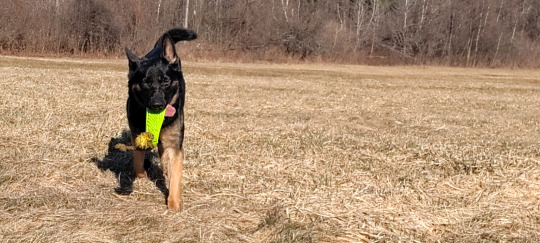
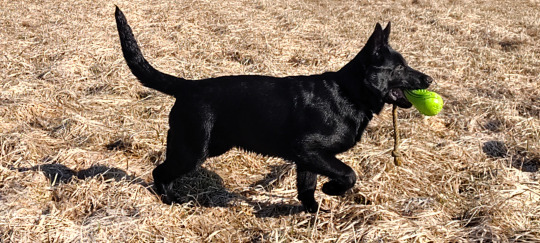

Morning run around and gets ants out of your pants time.
#reese#tassie#german shepherd dog#gsd#puppy stories#can i just say that i am DELIGHTED by tassies structure already#and shes only five months#look at that form she is going to be gorgeous
5 notes
·
View notes
Note
No pressure to answer this, only if it's fun: I know the pictures are a bit blurry, but I'd be interested to hear what you think of the Dobermans in the Bela Lugosi pics! How do they compare to modern ones? I have seen some pics of older Dobermans but usually earlier than those so I'm curious about this kinda mid-stage between today's Dobermans and the very first standardized ones.
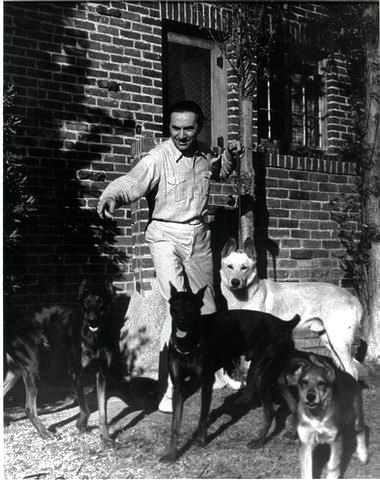

Anon is talking about these dogs, for reference.
The photos are from the 1930s so they are not really the "first" standardized dobes as by this point Dobermann was dead and the dogs were in Nazi hands controlling the breeding and standard. Bela's dogs specifically would not have been, simply due to the fact that A: he was American and B: he has a white GSD from the looks of it, which Hitler wanted culled and eradicated from the breed. These midway dogs are pretty much exactly what I'd expect from a 1930s dog, since many American dobes at this point were either direct imports from Germany or only a generation or two off, mostly sent over here to protect them from dying out due to war and recession.
The breed is most of the way "done" at this point, just missing some of the refinement of later generations. As you can see, they are very recognizably dobermans, but they are also lacking dep chests and some of the more sighthound look of the later years. These crops are still quite short, though longer than the crops of yesteryear, and the dock has been moved to the second vertebrae instead of right at the pelvis.
There still exists some dogs who look quite a good deal like these, though for the most part I would say many would be not so well bred, due to the obvious structure faults I'm seeing in these photos as well.
22 notes
·
View notes
Text
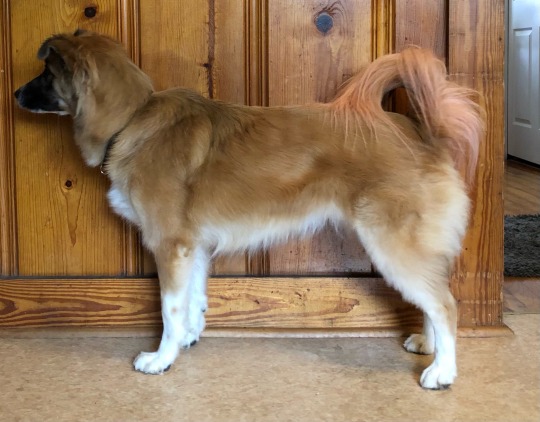
@ structure peeps, thoughts on Maki? I’m really bad at reading structure, especially fronts. But I feel she’s not bad for a fairly early spay in a shelter mutt. I really like her head, and I think her front is not as bad as I thought it was. Hard to see her rear very well bc she kept stepping forward, that was the best I could get on her back legs. I know she needs more chest bc that’s all just fluff that you see. But she’s 3 so I think she’s done filling out.
Edit to add: I got this as straight as possible but my floor is actually crooked so...it’s hard to make her stand on a flat surface haha.
10 notes
·
View notes